|
Ah, October. As summer’s scorching
temperatures become a historical item, and the flood episodes
of September’s deluges lose their intensities, I embrace
the pleasant daytime temperatures and cool nights of fall
with open arms. Perhaps it is my diminishing resistant to
those hundred plus degree days, when I wear sunblock and sunglasses
indoors. Like the lizards with whom they share this desert
land, many Moabites lament the transformation of summer. They
bask in the desert heat like their reptilian ancestors, but
I say, shorter days and cooler nights - bring ‘em on.
Perhaps it is my New England heritage that starts to rise
like sugar content in an autumn maple leaf that makes me cherish
this season of colorful transition. Say goodbye to the green
cloak of summer and hello to the romantic blush of autumn.
As a Connecticut Yankee I once heard a tale of why leaves
turned color in the fall. That legend blamed that old rascal
Jack Frost, whose amorous appeals while courting Mother Nature
caused her to blush like a schoolgirl. When Old Man Winter
caught wind of Jack’s adventures, he’d descend
like a bad dream over the land, and those flushed cheeks would
lose their crimson color.
Though I could find appreciation in the color schemes that
stitched the woodlands together like a grandmother’s
quilt, even if I was skeptical of this legend, I regretted
the seemingly endless days of raking and bagging the leafy
remnants of crushed dreams. With winds bearing from our neighbor’s
yard, never the reverse, I spent many a day on the long end
of a rake.
But during this time I was given an opportunity. A closer
inspection of the leaves impaled on the tines of my rake,
opened up a palette of colors that would make Crayola ®
jealous. There were flames of color shooting along the leafy
fingers, and the various species of hardwoods added texture
and form to the whole, their signatures defined by wavy margins
or deep, canyon-like lobes. I gained a greater sense of appreciation
for the intricate patterns of veins that had once played a
life-sustaining role to these stalked storehouses of photosynthesis.
Soon raking leaves was no longer a chore. I’d collect
the colorful jewels of maple, hickory, locust, and birch and
squirrel them away in the recesses of books and magazines.
They would turn into bookmarks or art projects or be forgotten
and crushed into tiny pieces. It wasn’t until years
later, while studying botany in the land of evergreens that
I really understood the process behind this autumnal blush.
Leaves contain several different types of pigments. Chlorophyll
is the most noted and since these pigments absorb red and
blue light from sunlight they reflect back light that appears
green. Plants need to constantly synthesize chlorophyll during
the growing season because this pigment breaks down in sunlight
and is the primary site where photosynthesis takes place.
Other pigments found in these leaf cells, called carotenes
or anthocyanins, are mostly masked by the chlorophyll. But
with shorter days and cooler temperatures in fall, this triggers
a change in the plant’s production of chlorophyll. Along
with this decreased production, a growth of corky cells forms
a membrane between the branch and the tree leaf. Eventually,
this membrane will seal off this connection, creating the
leaf to sever from the branch and descend to earth. During
this termination process the underlying pigments are like
supporting actors - they get their moment in the limelight.
The light reflected from these pigments appears yellow, red
or orange, or some fiery combination thereof.
Extending this colorful procession is a combination of warm
days and cool nights; freezing temperatures or hard rains
will soak the relationship, causing the leaves to prematurely
age, turn brown and die. So even though I know I’ll
have much work ahead raking and piling leaves for garden decomposition,
I relish this time of year as much as Jack Frost does during
his season of courting.
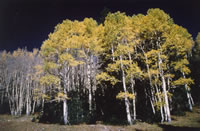
|
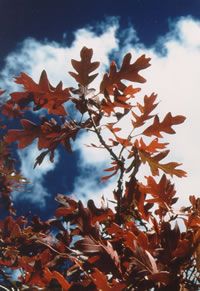
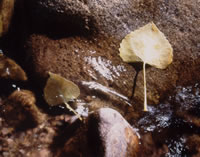
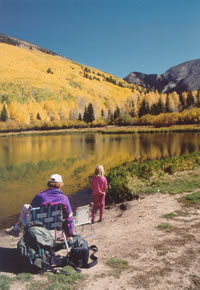
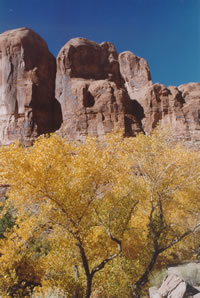
|
 NATURE
HAPPENINGS - October 2003
NATURE
HAPPENINGS - October 2003



